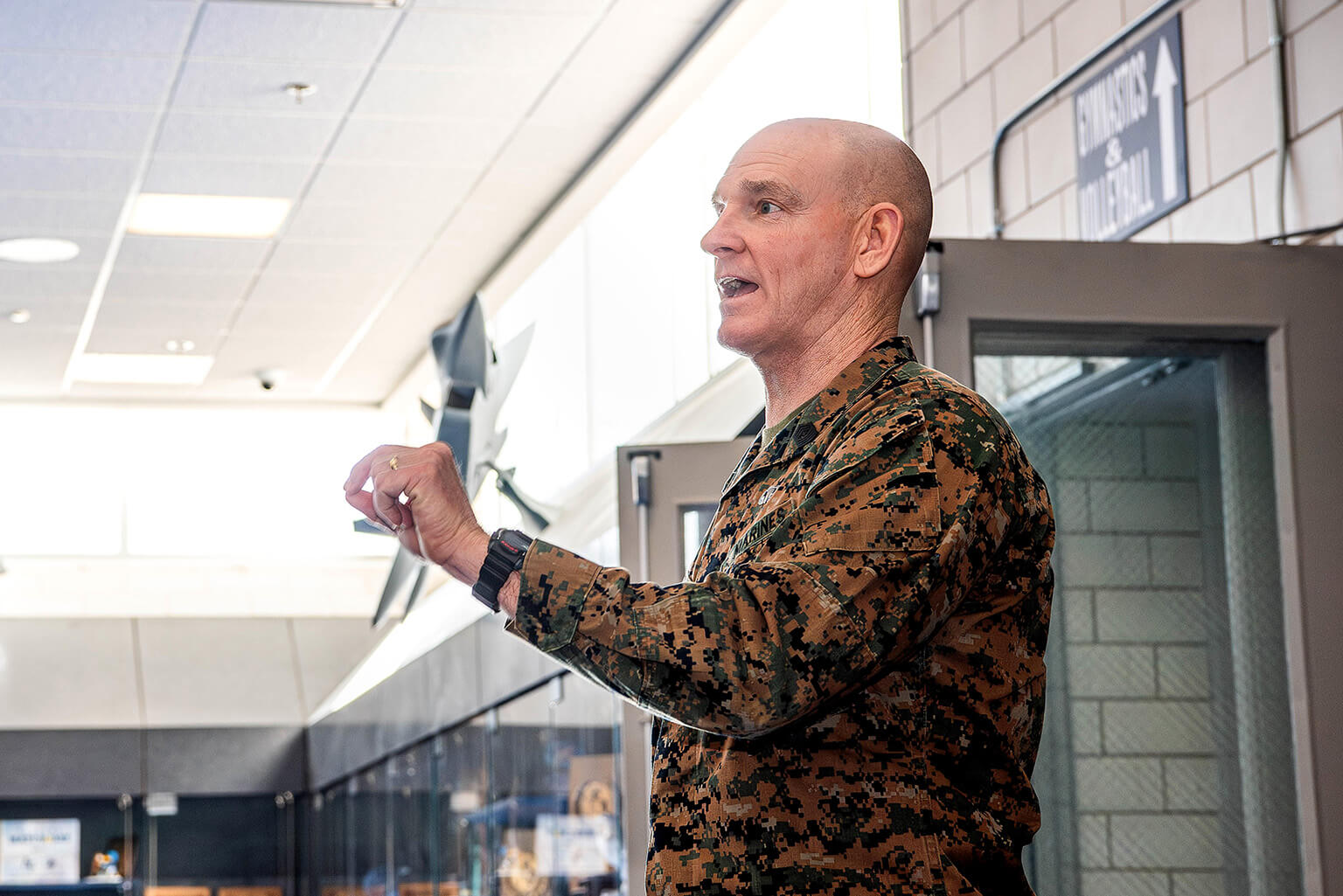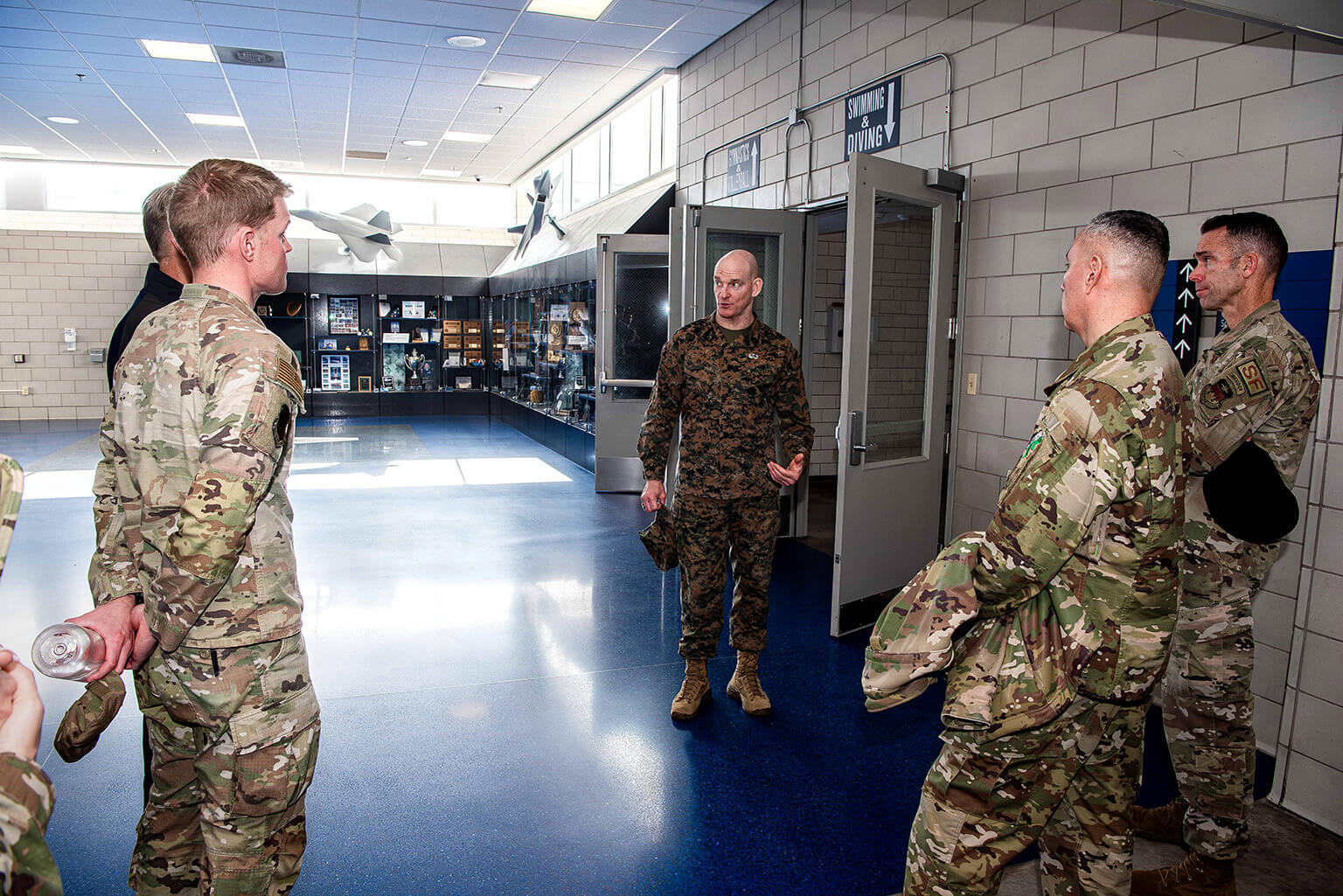SEAC encourages cadets to listen, lead
 Senior Enlisted Advisor to the Chairman Troy E. Black speaks at the U.S. Air Force Academy Athletic Department during a visit to Colorado Dec. 20, 2023. Black visited the Academy on his tour of all Defense Department combatant commands after taking the role in November 2023. (U.S. Air Force photo by Trevor Cokley)
Senior Enlisted Advisor to the Chairman Troy E. Black speaks at the U.S. Air Force Academy Athletic Department during a visit to Colorado Dec. 20, 2023. Black visited the Academy on his tour of all Defense Department combatant commands after taking the role in November 2023. (U.S. Air Force photo by Trevor Cokley)
Katherine Spessa
U.S. Air Force Academy Strategic Communications
U.S. AIR FORCE ACADEMY, Colo. – Senior Enlisted Advisor to the Chairman Troy E. Black visited the U.S. Air Force Academy on Dec. 20 and took the opportunity to share a senior NCO’s leadership philosophy with enlisted members, cadets and newly commissioned lieutenants.
Since his appointment in November, Black has embraced his new joint role as spokesman for the enlisted force and as the enlisted advisor to the highest-ranking member of the armed forces – it’s something he has been doing at every level for decades.
“In almost every military organization, an officer is paired with an NCO,” Black said. “The NCO may lack the academic rigor that an officer has gone through, but they have absolutely every bit of experience that that junior officer needs. So, you pair the two. It’s a balance of experience and authority that makes a true leadership team.”
As cadets commission as second lieutenants and integrate into their new career fields and units, Black recommends, “First, listen.”
As a young infantry platoon sergeant, Black and his unit returned from a deployment to a new lieutenant assigned as their platoon leader. After a two-month ship voyage across the Pacific from combat, the lieutenant wanted to assess the fitness of the platoon by running hills.
“I asked the lieutenant – ‘Have you ever run on a ship before?’ and he said ‘Well, no.’ So I said, ‘Let’s do this. Let’s go on a conditioning hike because that’s what they’re conditioned to do right now. Then let me offer you the opportunity to develop a physical fitness program because we need to get back into shape to meet the Marine Corps standard. That’s your responsibility and I’m here to assist you,’” explained Black. “That’s what we did, and he was one of the best platoon commanders I’ve ever worked for.”
During his four years as Sergeant Major of the Marine Corps, Black attended each graduation of the Basic Course, a course that each commissioned officer in the Marines attends, regardless of their commissioning source. His advice to each class was the same:
“Remember that you are leaders. But you are also leading leaders; you’re not leading subordinates. Lead through them.”
This advice is particularly timely as the U.S. Air Force begins its shift toward mission command, the practice of conducting military operations through decentralized execution. While the Air Force has historically focused on decentralized execution, the operational environment over the last several years has typified centralized execution at all levels.
With a shift in the operational environment, the Air Force released Air Force Doctrine Publication 1-1, Mission Command, illustrating the mission command principles of centralized command, distributed control and decentralized execution.
It is a leadership philosophy centered on the “art of command” that the Marine Corps and U.S. Army have been practicing for decades, and the Air Force will now benefit from their best practices as the force begins to employ its newest tenet.
After 35 years of experience as an infantryman, Black has his own mission command lessons and best practices to share with cadets and junior officers at the Academy as they enter active duty under this new leadership philosophy and operational picture.
“Mission command doesn’t tell you how to do it, it tells you what the end state is. As a commander, you give your intent and allow those you’re leading to think creatively to get the job done,” he said. “Give them the initiative to make adjustments along the way.”
To enable this type of command, leaders must first set the example and trust them to accomplish their mission once given intent and left and right limits.
“You first have to observe your leader doing the right thing in order for them to influence them to do the right thing,” Black said.
 Senior Enlisted Advisor to the Chairman Troy E. Black speaks with members of the Athletic Department during a visit to the U.S. Air Force Academy, Colo. Dec. 20, 2023. Black toured the Academy and learned of its mission to develop leaders of character. (U.S. Air Force photo by Trevor Cokley)
Senior Enlisted Advisor to the Chairman Troy E. Black speaks with members of the Athletic Department during a visit to the U.S. Air Force Academy, Colo. Dec. 20, 2023. Black toured the Academy and learned of its mission to develop leaders of character. (U.S. Air Force photo by Trevor Cokley)